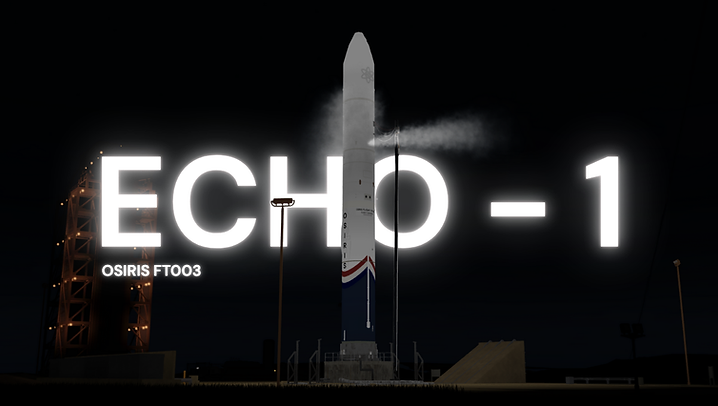01/01/2023
BREAKING NEWS
GTRAD RETURNS TO THE INDUSTRY ACHERON FIRES ITS SEVEN ENGINES FOR THE FIRST TIME WILL OSIRIS EVER FLY AGAIN? MONTHS OF HARDWARE AND MANAGEMENT CHANGES MAKE THE VEHICLE'S FUTURE UNCERTAIN WHAT HAPPENED TO KARMAN AEROSPACE? TOTAL SILENCE FROM THE COMPANY CONFUSES THE INDUSTRY
Celestial Space Prepares for Long Awaited Return to Flight
After a year of delays and internal overhauls, Celestial Space prepares to return to flight. The upcoming ECHO 1 mission marks the debut of a heavily upgraded Osiris rocket, and hints at a new ambition just around the corner.
24 July, 2025
John Doe
This article is classed as
ACCURACY REALISM

Promotional thumbnail for ECHO-1. Image: Celestial Space Corp.
For the first time in nearly a year, Celestial Space is preparing its Osiris rocket for launch. The mission, designated EA-ECHO 1, will be the vehicle’s third flight and the first to carry a commercial payload, kicking off Celestial's entry into the commercial launch market.
Liftoff is expected on the 9th of August from Space Launch Complex 1, where teams have been conducting integration and testing over the past several weeks.
The payload, a communications satellite for Expedition Aerospace, will be the first installment in a proliferated constellation designed to provide low latency, resilient military communications across multiple orbital layers.
It’s a high profile customer for a rocket that has, until now, only flown internal demonstration missions.
The Osiris rocket flying ECHO 1 is not the same rocket that launched a year ago. The vehicle has undergone a wide ranging upgrade to nearly every major subsystem.
The first stage solid fueled booster features new casting and manufacturing techniques that increase burn efficiency, reduce vibrations, and improve performance reliability. It is also the first Osiris booster to carry recovery systems, marking the beginning of the shift toward reusability.
Meanwhile, the second stage has been entirely redesigned. With the retirement of the vehicle’s former third stage, engineers have stretched the second stage to compensate, allowing it to carry more propellant and sustain longer burns.
A white painted insulation layer has been added to the exterior of the cryogenic tank, helping retain its cryogenic propellants during extended periods in space.
The Nova-1B vacuum engine, which powered Osiris’s previous two flights, has been retired in favor of the new Nova-1C, an upgraded variant offering higher thrust, better efficiency, and reduced weight.
Internally, engineers describe the new stage as the “first true production model” for Osiris.
“The Block 1 and 1.1 of our rocket was really a holdover from the earliest Osiris designs,” said the founder and CEO of Celestial Space, Kwingo. “It worked, but it was built when the company was still finding its place. This new design reflects where we are now, not where we were then.”
One of the most critical components of this flight will come after payload deployment. The solid booster will attempt to splash down off the coast of Vlieland and be recovered.
The stage is outfitted with Celestial’s new Mark 3 parachute system, which recently passed a full testing campaign of drop tests using non flight hardware.
“Mark 3 performed extremely well during qualification,” said a recovery systems engineer. “We’re confident this flight will give us valuable data, and maybe even a usable stage.”
The recovery program has operated quietly in the background of Celestial’s development efforts, but has grown significantly in experience over the past year. If successful, the data from this mission will shape the design of future recovery hardware for Osiris and its successor vehicles.
In a visual departure from earlier flights, the Osiris booster will fly with a new paint scheme. The first stage is now dark blue, accented with red, white, and blue stripes, a stylised version of the Dutch flag, in tribute to Celestial’s national origin.
Though ECHO 1 is officially a return to flight mission, it is suggested that it may be more than that.
While the current launch marks a milestone return, internal sources suggest Celestial Space may be planning something even larger.
Kwingo hinted at a significant design overhaul in a recent media event, he talked about Osiris as “our foundation for growth, but not the final choice.”
Recent sightings of new, wider diameter rocket components entering the Vlieland facilities have led to speculation that an Osiris successor, or at least a substantially upgraded variant, is in the works.
“The original Osiris was born when we were a much smaller company,” Kwingo said. “Now we’re growing into what we were always meant to become.”
With launch preparations underway, all eyes are on Vlieland this August as Celestial Space aims to demonstrate its return to flight operations after 11 months of delay.
“This flight isn’t just a launch. We’re back.”





